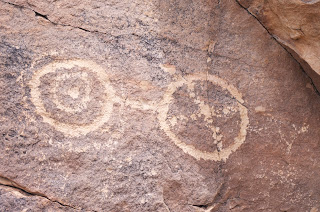China Draw, McGee Canyon( Sunman Site)
These two smaller rock art sites are in Luna County, north of Deming, close to the larger and more well known sites at Pony Hills and Frying Pan Canyon. The China Draw Site is on a section of state trust land, a stone's throw away from the Hidden Valley Ranch RV resort, which is at the terminus of well-maintained county road, so I am sure it gets visited by lots of people, yet on this past Sunday, David and Nancy Soules and myself were the only folks there, wandering among the sandstone outcrops and boulders, climbing on top of a few to see what we could discover. Lower down just up from the bank of the draw is a dark gray rock covered with an assortment of elaborate petroglyphs. Further up the hillside are three orange and tan outcrops that are about 15 feet high. They are surrounded by numerous grinding mortars and have petroglyphs on every side and even on top. Many of the glyphs are similar in style those found at Pony Hills and Frying Pan, but as always there are few that seem unique to the site. We explored the many outcrops, boulders and few cliffs, but it seemed that most of the art was concentrated in these two spots. I had begun to walk up to the higher cliffs, when I heard "the buzz" and quickly scoped out the thin neck and triangular head of a blacktail rattler in little hollow among the rocks. I turned back, so there could be a few more petroglyphs up high although I doubt it. I have been very close to this site on two different hikes over the years, and I've known of its existence for many years, but for some reason never took the time to look at it. Given its ease of access, and perhaps even without, it certainly exceeded all of our expectations.
We then headed, via a very rough and slow crossroad, with the mines of Fluorite Ridge visible to the north, over to the Greenleaf Mine Road( another well maintained county road). We drove northeast where we got onto another very slow road just past Starvation Draw Dam # 2, stopping at a point about a mile directly west of McGee Canyon. It is possible to halve that distance by using a different low maintenance road that also heads northeast from a point close to the east end of the Starvation Draw Dam # 1.
McGee Canyon is a rocky little defile on BLM land, that incises itself deeply into the ridge that is the western edge of Frying Pan Canyon. It heads west for less than a mile before joining the much larger arroyo that is dammed by Starvation Draw Dam # 3. Coming at it from the west we crossed creosote flats, climbed a few mounds, eased in and out a couple of large arroyos, and stepped over another road as well. It is not on maps as far as I can tell. Where it starts, I can't say. All the while we kept a line toward some cliffs that we took to be the entrance to the little canyon. At the mouth was a large juniper, and there were more further up the stream course as well. There was also the high dried grasses of last summer, and much scrub oak, which were further indicators that water lingers in this canyon and that it may even have seasonal springs. We all speculated that in times past perhaps China Draw and Starvation Draw themselves had, if not perennial flow, then extended seasons of surface flow. Which may explain why this place was attractive to ancient peoples.

We found an old mine with blue-gray tailings that had hardened like cement, a " cave" made from 3 massive boulders leaning against each other, grinding mortars, and of course many petroglyphs.
What we did not find was the icon for this site: the large Sunman, a humanoid with a small head, large eyes and a rectangular spiral for a body.


We were a little pressed for time on this day, but this is really neat place so I feel that a return trip in cooler weather is highly probable. On the hike back, the clouds that had been keeping us cool departed, and the temperatures rose to the predicted low 90's. The pleasant breeze turned into a steady west to east wind, that blew my sombrero off over and over. Happily, we didn't have all that far to go, and we all made it back to the truck in good shape.
NOTE: The case could be made that the art at both of these sites is less abundant and perhaps lacks the craftsmanship, artistry and imagination that is so apparent at both Pony Hills and Frying Pan Canyon, but their proximity makes it easy to visit all four with two different hikes. China Draw can be seen by extending a visit to Pony Hills (or vice versa) perhaps just a little more than a mile, and very short loop hike could allow one to visit both Frying Pan and McGee Canyon.
Labels: hiking, petroglyphs





































2 Comments:
So cool! I would love to see something like this some day, thanks for the share!
Kendell
To peak you interest, there are two Sunmen! A large one about 3x3 feet and it is a seasonal marker. The smaller one on top of a large car-sized bolder is only about 10" high. From the smaller one you can 'see' a rock window and from that location the sun rises through that window on Mar 21 and Sept 21.
puma-243@q.com
Post a Comment
Subscribe to Post Comments [Atom]
<< Home